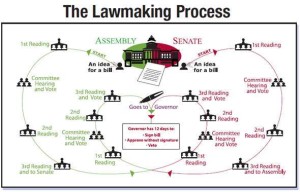As an Alternative, Eliminate the Archaic 30-Days-In-Print Rule
On January 7, 2013, Senate President Pro Tempore Darrell Steinberg, a Sacramento Democrat, violated one of the chief rules of public relations by trying to blunt potential criticism of the upper house by drawing attentiont o the opportunity for leveling it.
As the Senate’s first floor session of 2013 drew to a close, Steinberg allowed that the public and might be critical of the lack of legislative business conducted during the first months of the legislative session.
He blamed legislative inaction on the 30-days-in-print waiting period that must transpire between a bill’s introduction and when it is heard and voted on in committee.
Since debating legislation isn’t an option for awhile, Steinberg said he wanted to explore “how we can use this floor in a productive way in the next couple of months. Take some time and study together. Talk about issues.”
Perhaps bring in a few guest speakers, the Sacramento Democrat said.
(California’s Capitol nominates Jon Stewart as Guest Speaker #1. Followed by Eureka’s Betty Chinn.)
Another option for the Senate might consider is getting rid of the 30-days-in-print rule, which can be found in the California Constitution’s Article IV, Section 8 (a):
 “At regular sessions no bill other than the budget bill may be heard or acted on by committee or either house until the 31st day after the bill is introduced unless the house dispenses with this requirement by roll call vote entered in the journal, three fourths of the membership concurring.”
“At regular sessions no bill other than the budget bill may be heard or acted on by committee or either house until the 31st day after the bill is introduced unless the house dispenses with this requirement by roll call vote entered in the journal, three fourths of the membership concurring.”
In other words, absent a vote of the full Assembly or the Senate to the contrary, every bill idles for a month.
The rule has been enshrined in the state constitution since 1911.
Back then, the Legislature was required to recess for 30 days to allow the state printer time to typeset and publish bills. The 30-day recess was abolished by Proposition 9 in 1958 but the 30-day waiting period on hearing bills remained.
“The practical effect has been that many bills are introduced with only intent language and then sit for 30 days, thereby reducing public access to the final bill language,” reads a February 21, 2008 Assembly memo on the issue.
While agreeing that the constitution explicitly prevents a bill from having a hearing or being voted on during the 30-days-in-print window, the Assembly and the Legislature’s lawyers found nothing in Article IV, Section 8 (a) to prevent the author of legislation from amending it during those 30 days.
And, as of the date of the memo quoted above, lawmakers in the lower house were permitted to amend their bills while the 30-day clock ran.
“Allowing author’s amendments to be adopted during this waiting period is in keeping with the constitutional intent of providing ample time for the public to study proposed legislation prior to its first public hearing,” the memo says.
The Senate chose not to embrace the Assembly’s, at best, halfway measure in ebtter legislative time management.
In a world where information is transfered instantly, where access comes with the click of a mouse, the need for a 30-day wait period has gone the way of the dodo, 8-Track and the mullet. Put a constitutional amendment on the ballot and end the practice.
Although if it’s going to be a choice between more quickly authorizing a Joint Powers Agreement on Mosquito Abatement between Ripon and Manteca or Jon Stewart live from the floor of the California State Senate — even Betty Chinn live — then why abandon a law that’s served California so well for so many years.
-30-
Filed under: Legislature/Legislation, Venting
- Capitol Cliches (16)
- Conversational Currency (3)
- Great Moments in Capitol History (4)
- News (1,288)
- Budget and Economy (383)
- California History (139)
- Demographics (11)
- Fundraising (74)
- Governor (122)
- Legislature/Legislation (270)
- Politics (173)
- State Agencies (38)
- Opinionation (36)
- Overheard (246)
- Today's Latin Lesson (45)
- Restaurant Raconteur (21)
- Spotlight (110)
- Trip to Tokyo (8)
- Venting (184)
- Warren Buffett (43)
- Welcome (1)
- Words That Aren't Heard in Committee Enough (11)

No Comments »
No comments yet.
RSS feed for comments on this post.
Leave a comment